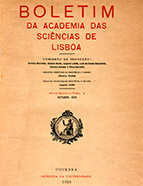

................................
The Boletim produced 49 volumes annually. The distribution of issues during the calendar year was irregular, varying greatly, but there was always a break during the holiday months of August and September. The following table presents information on ten randomly selected years of publication, arranged in descending order of page count:
(1) With a single four-monthly issue for July-October. (2) Quarterly figures for May-July and October-December. (3) October-November bimonthly issue. (4) Monthly in October, November and December; bi-monthly in January-February and June-July; quarterly in March-May. (5) Issues dedicated to January-March (quarterly), April-July (four-monthly) and August-December, in this case 5 months. (6) Monthly figures for March and December, the rest bi-monthly. (7) Only the figures for October/December have been published.
The publication frequency ranged from monthly to quarterly, and at times, it even extended to five months, as was the case between 1968 and 1973. After the 25th April Revolution, the issues became annual, starting in 1975 with Volume 47. The volumes from 1975 and 1976 were comparatively small, with editions of 260 and 238 pages, a trend that had already been observed in 1970 and 1973, where the average page count was less than three hundred per year.
As the ACL is one of the oldest academic institutions in the country still in operation, it is naturally of interest to examine whether this second series of the Boletim shows signs of vitality and internal activity. Although it includes renowned figures from Portuguese culture— we will explore how significant the records of members’ entries or their advancement in the academic hierarchy were, as well as the funeral eulogies for members delivered by those who succeeded them, a tradition as old as the Academy itself— it cannot be inferred that the thousands of pages accumulated over so many years of publication contain fundamental texts of 20th-century Portuguese arts, humanities, and sciences, at least in the fields of history and culture. In fact, this issue can be traced back to the Academy’s 19th-century existence: the challenge of demonstrating how the institution contributed to the country by being a stage for pivotal interventions in the advancement of historical and scientific knowledge of the past. The historical periods and cultural themes addressed were as varied as the centenaries commemorated (such as those of Montaigne, Racine, and Goethe) or the fields typically explored by figures such as Queirós Veloso (16th to 17th centuries), Afonso de Dornelas (heraldry and phaleristics ), Moisés Amzalak (translations of classical British economists in Portugal), José de Figueiredo (tapestries by Pastrana and Damião de Góis and art criticism), and Fidelino de Figueiredo (unexpectedly, Hollywood cinema), just to name a few texts from the 1930s. Other examples include the history of the discoveries, the Academia das Ciências , and cartography.
This work is financed by national funds through FCT - Foundation for Science and Technology, I.P, in the scope of the projects UIDB/04311/2020 and UIDP/04311/2020.
